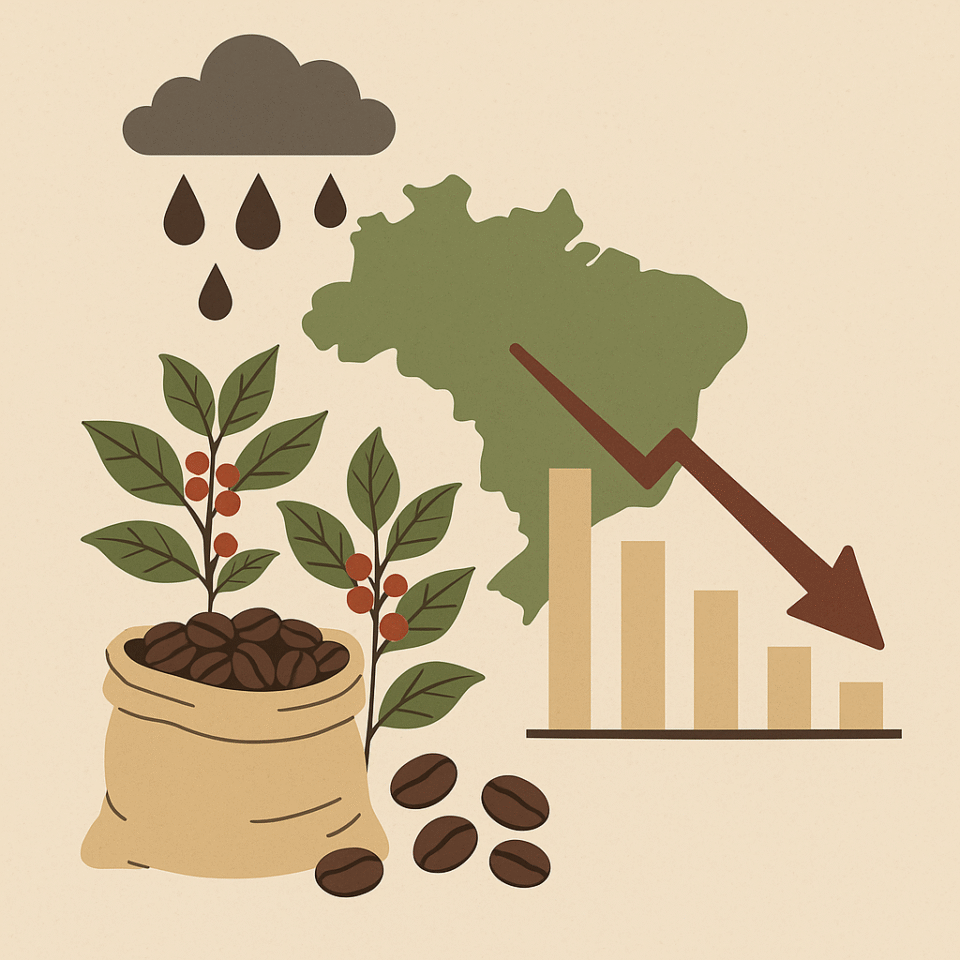Dubai – Qahwa World
Arabica coffee prices fell sharply on Thursday as forecasts of much-needed rainfall in Brazil’s key coffee-growing regions eased concerns about prolonged dryness that had recently pushed prices higher. Meanwhile, robusta prices edged up, supported by steady demand and limited inventories.
On the Intercontinental Exchange (ICE), December arabica (KCZ25) closed down –7.85 cents (–2.04%) at 297.05 U.S. cents per pound, while November robusta (RMX25) gained +26 points (+0.57%), reaching a three-week high.
Brazil Weather Outlook
According to Brazilian meteorological agency Climatempo, parts of Minas Gerais — the country’s largest arabica-producing region — could receive up to 30 millimeters of rain this week, a “significant amount” expected to promote flowering for the 2026/27 crop cycle. The prospect of rainfall led to profit-taking after recent price gains fueled by drought concerns.
Earlier this week, Somar Meteorologia reported that Minas Gerais received only 0.9 millimeters of rain during the week ended October 4 — just 3% of the historical average — raising fears of poor flowering and lower yields before these latest forecasts.
Inventory and Trade Developments
While weather news weighed on prices, global supply signals remained tight. ICE-monitored arabica inventories fell to a 1.5-year low of 519,534 bags on Thursday, while robusta inventories hit a 2.5-month low of 6,237 lots. The sharp drawdown is partly linked to the 50% tariff on U.S. imports of Brazilian coffee, which has caused American buyers to void new contracts and tightened U.S. supplies. Brazil accounts for around one-third of America’s unroasted coffee imports.
At the same time, the International Coffee Organization (ICO) reported that global coffee exports for the current marketing year (Oct–Aug) rose by 0.2% year on year to 127.92 million bags, indicating adequate supply in the short term but little room for further tightening.
Production and Export Trends
Brazil’s crop forecaster Conab recently revised down its 2025 arabica crop estimate by 4.9% to 35.2 million bags (from 37 million in May) and cut total coffee output to 55.2 million bags (from 55.7 million). Meanwhile, Cecafé, the Brazilian exporters’ association, said coffee shipments fell 21% in the first seven months of the year to 22.2 million bags and plunged 28% in July alone.
In contrast, Vietnam — the world’s largest producer of robusta — is seeing strong growth. The Vietnam National Statistics Office reported that coffee exports from January to September 2025 rose 10.9% to 1.23 million metric tons, with the 2025/26 harvest expected to increase 6% to 1.76 million tons (29.4 million bags), a four-year high.
Global Outlook
The U.S. Department of Agriculture’s Foreign Agricultural Service (FAS) forecasts global coffee production in 2025/26 to reach a record 178.68 million bags, up 2.5% year on year. Within that total, arabica output is expected to decline 1.7% to 97.02 million bags, while robusta is projected to rise 7.9% to 81.65 million bags. Ending stocks are forecast to increase by 4.9% to 22.82 million bags.
However, trader Volcafe projects a global arabica deficit of 8.5 million bags for 2025/26 — wider than the 5.5 million bag deficit in 2024/25 — marking the fifth consecutive year of shortfall.
Adding to market uncertainty, the U.S. National Oceanic and Atmospheric Administration (NOAA) on September 16 raised the probability of a La Niña event between October and December to 71%. Such conditions can cause dry weather in South America and potentially damage Brazil’s next coffee crop, maintaining a tense balance between short-term relief and long-term risk.
Market Summary
For now, traders remain focused on Brazil’s rainfall patterns and their impact on flowering and yields. If forecasted rains fail to materialize, a renewed price rebound could follow as concerns about crop development resurface. Conversely, consistent rainfall in October could alleviate some supply pressures and bring temporary stability to arabica prices.
